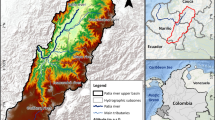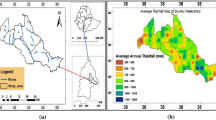Abstract
This paper analyzes the meteorological drought events in Paraguay in the period of 1964 to 2011, using the Standardized Precipitation Index (SPI). The objective is to determine if the frequency and/or severity of droughts has increased or decreased in the last years, in response of climate change. They The southernmost parts of the country are affected by severe droughts producing damage to soybean and corn crop during the rainy season (October–March) especially during the summer of 2008–2009. The years of 1967, 1968, 1978, 1979, 2000 and 2008 was identified as severe to extreme drought events and coincides with La Niña event. However, the relationship between all drought events, especially those agricultural droughts and La Niña is not clear, suggesting the necessity of new research, focusing on new drivers to explain the cause of the droughts. The economy of Paraguay, based for good part on agriculture, is clearly vulnerable to droughts. Even though no undeniable increasing trend in drought frequency/severity was detected, contingency plans to diminish drought impacts ought to be elaborated.



Similar content being viewed by others
Notes
National Weather Service is a dependency from DINAC, in charge of meteorological observations at national level.
References
Agnew CT (2000) Using the SPI to identify drought. Drought Netw News 12:6–12
Bulletin of the Meteorological Society (BAMS) (2014) American Meteorological Society (AMS): statement on meteorological drought. Bull Am Meteorol Soc 85:771–773
Báez, J. y Fernández, W. (1994) Distribución Espacial y Temporal de la Precipitación en Paraguay. Revista Geofísica del Instituto Panamericano de Geografía e Historia - IPGH N° 41, Julio–Diciembre de 1994. ISSN-0252-9769
Bhalme HN, Mooley DA (1980) Large scale droughts/floods and monsoon circulation. Mon Weather Rev 108:1197–1211
Central Bank of Paraguay (2009) Cuentas Nacionales de Paraguay (in Spanish). http://www.bcp.gov.py/Noticias/Informe_CNT_II_2009.pdf
CEPAL (2010) Estudio económico de América Latina y el Caribe • 2009-2010. http://www.cepal.org/publicaciones/xml/3/40253/LCG2458_Paraguay_final.pdf
Collishonn W, Tucci C, Clarke R (2001) Further evidence in changes in the hydrological regime of the River Paraguay: part of a wider phenomenon or climate change? J Hydrol 245:218–238
Fraisse C, Cabrera V, Breuer N, Báez J, Quispe J, Matos E (2008) El Niño southern oscillation influences on soybean yields in eastern Paraguay. Int J Climatol 28:1399–1407
Gibbs, W. J. and Maher, J. V. (1967) Rainfall deciles as drought indicators, Australian Bureau of Meteorology Bulletin, No. 48, Commonwealth of Australia, Melbourne, 37
Grimm A (2004) How do La Niña events disturb the summer monsoon system in Brazil? Clim Dyn 22:123–138
Grimm A, Barros V, Doyle M (2000) Climate variability in Southern South America associated with El Niño and La Niña events. J Clim 13:35–90
Guttman NB (1998) Comparing the palmer drought index and the standardized precipitation index. J Am Water Resour Assoc 34(1):113–121
Jones PD, Hulme M (1996) Calculating regional climatic time series for temperature and precipitation: methods and illustrations. Int J Climatol 16:361–377
Liebmann B et al (2004) An observed trend in Central South American precipitation. J Clim 17:4357–4367
Loukas A, Vasiliades L (2004) Probabilistic analysis of drought spatiotemporal characteristics in Thessaly region, Greece. Nat Hazards Earth Syst Sci 4:719–731
Masuda, T. and Goldsmith, P. (2009) World Soybean Production: Area Harvested, Yield, and Long-Term projections. International Food and Agribusiness Management Review. Volume 12, Issue 4
McKee, T. B., Doesken, N. J., and Kleist, J. (1993) The relationship of drought frequency and duration to time scales, Preprints, 8th Conference on Applied Climatology, Anaheim, CA. Amer. Meteor. Soc., 179–184
Palmer WC (1965) Meteorological drought. Research paper no. 45. U.S. Weather Bureau, Washington, p 58
Penalba OC, Rivera JA (2013) Future changes in drought characteristics over Southern South America projected by a CMIP5 multi-model ensemble. Am J Clim Chang 2:173–182
Piechota TC, Dracup JA (1996) Drought and regional hydrologic variation in the US: associations with the El Niño-Southern Oscillation. Water Resour Res 32(5):1359–1373
Podestá G, Letson D, Messina C, Royce F, Ferreyra A, Jones J, Hansen J, Llovet I, Grondona M, O’Brien J (2002) Use of ENSO-related climate information in agricultural decision making in Argentina: a pilot experience. Agric Syst 74:371–392
Skansi M, Brunet M, Sigró J, Aguilar E, Arevalos JA, Betancur O, Castellón Y, Correa R, Omero J, Ramos A, Oria C, Pastén M, Sallons S, Villarroel C, Martinez R, Alexander L, Jones PD (2013) Warming and wetting signals emerging from analysis of changes in climate extreme indices over South America. Glob Planet Chang 100:295–307
Van Rooy MP (1965) A rainfall anomaly index independent of time and space. Notos 14:43–48
Vera C, Silvestri G, Barros V, Carril A (2004) Differences in El Niño response over the South Hemisphere. J Clim 17:1741–1753
Vidal, J., Báez, J. and Lugo, L., (2009) Determination and analysis of the standardized precipitation index (SPI) as drought intensity indicator for Paraguay – a first approach. Impact of climate change on agricultural and natural ecosystems, ISBN 978-88-8453-920-5 (print), ISBN 978-88-8453-921-2 (online), © 2009 Firenze University Press
Wilhite DA (2000) Drought as a natural hazard: concepts and definitions. In: Wilhite DA (ed) Drought: a global assessment. Routledge, Evanston, pp 3–18
World Bank (2014) Agriculture. http://www.worldbank.org/en/topic/agriculture. Accessed 25 May 2014
Author information
Authors and Affiliations
Corresponding author
Additional information
This article is part of a Special Issue on “Climate change and adaptation in tropical basins” edited by Pierre Girard, Craig Hutton, and Jean-Phillipe Boulanger.
Electronic supplementary material
Below is the link to the electronic supplementary material.
ESM 1
(DOCX 1768 kb)
Rights and permissions
About this article
Cite this article
Benitez, J.B., Domecq, R.M. Analysis of meteorological drought episodes in Paraguay. Climatic Change 127, 15–25 (2014). https://doi.org/10.1007/s10584-014-1260-7
Received:
Accepted:
Published:
Issue Date:
DOI: https://doi.org/10.1007/s10584-014-1260-7




